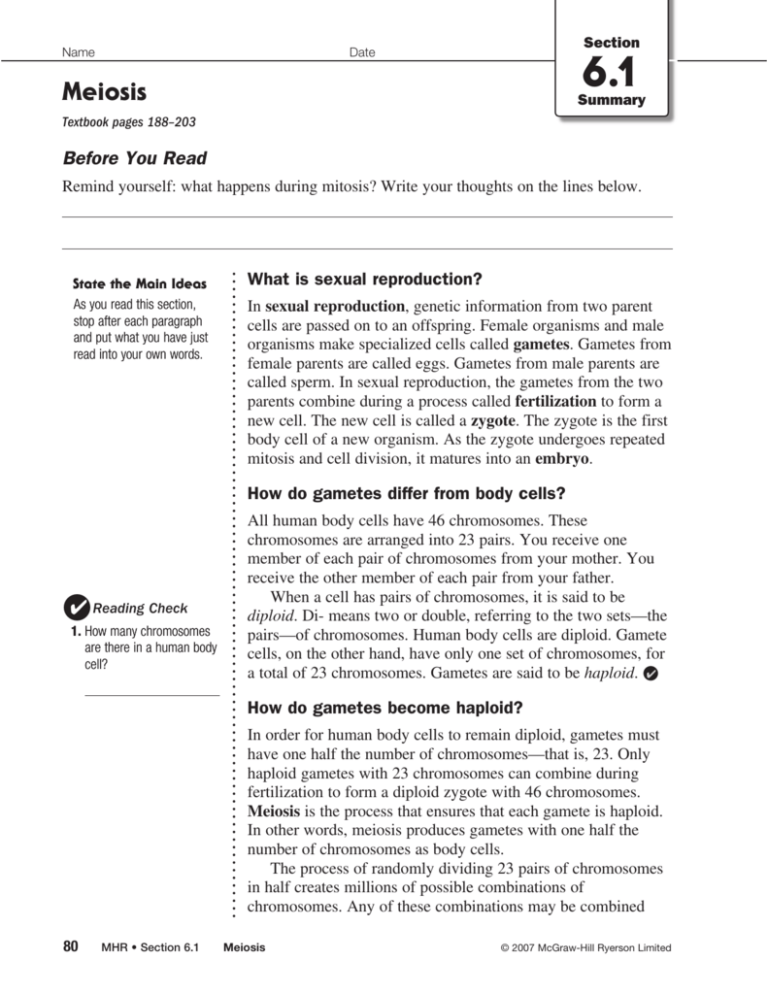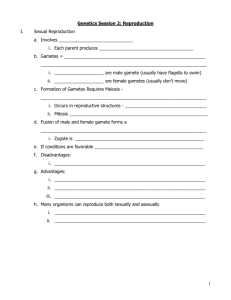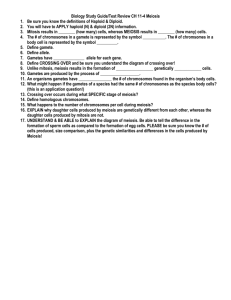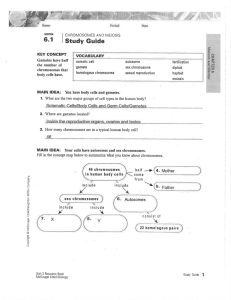Meiosis
advertisement

Name Section Date 6.1 Meiosis Summary Textbook pages 188–203 Before You Read Remind yourself: what happens during mitosis? Write your thoughts on the lines below. State the Main Ideas As you read this section, stop after each paragraph and put what you have just read into your own words. What is sexual reproduction? In sexual reproduction, genetic information from two parent cells are passed on to an offspring. Female organisms and male organisms make specialized cells called gametes. Gametes from female parents are called eggs. Gametes from male parents are called sperm. In sexual reproduction, the gametes from the two parents combine during a process called fertilization to form a new cell. The new cell is called a zygote. The zygote is the first body cell of a new organism. As the zygote undergoes repeated mitosis and cell division, it matures into an embryo. How do gametes differ from body cells? ✔ ● Reading Check 1. How many chromosomes are there in a human body cell? All human body cells have 46 chromosomes. These chromosomes are arranged into 23 pairs. You receive one member of each pair of chromosomes from your mother. You receive the other member of each pair from your father. When a cell has pairs of chromosomes, it is said to be diploid. Di- means two or double, referring to the two sets—the pairs—of chromosomes. Human body cells are diploid. Gamete cells, on the other hand, have only one set of chromosomes, for a total of 23 chromosomes. Gametes are said to be haploid. ● ✔ How do gametes become haploid? In order for human body cells to remain diploid, gametes must have one half the number of chromosomes—that is, 23. Only haploid gametes with 23 chromosomes can combine during fertilization to form a diploid zygote with 46 chromosomes. Meiosis is the process that ensures that each gamete is haploid. In other words, meiosis produces gametes with one half the number of chromosomes as body cells. The process of randomly dividing 23 pairs of chromosomes in half creates millions of possible combinations of chromosomes. Any of these combinations may be combined 80 MHR • Section 6.1 Meiosis © 2007 McGraw-Hill Ryerson Limited Section Name 6.1 Date Summary continued with chromosomes from the other parent in any gamete during fertilization. In this way, sexual reproduction and meiosis increase genetic diversity (variety) in a species. What happens during meiosis? Examine the diagram below. During meiosis, each chromosome in a cell is duplicated once and then the cell divides twice. The first division of the cell is called meiosis I. Meiosis I is similar to mitosis, but each pair of chromosomes includes one chromosome from each parent. These matching chromosomes are called homologous chromosomes. Meiosis I starts with a diploid cell and finishes with two haploid cells. Each of the two haploid cells undergoes a second division called meiosis II. Meiosis II starts with two haploid cells and ends with four haploid cells. So the overall process of meiosis starts with one diploid cell and ends with four haploid cells. ● ✔ ✔ ● Reading Check 2. In meiosis, how many haploid gamete cells result from one diploid parent cell? diploid parent cell meiosis I meiosis II DNA replication (chromosomes duplicated) haploid gametes © 2007 McGraw-Hill Ryerson Limited Section 6.1 Meiosis • MHR 81 Name Applying Knowledge Section 6.1 Date Use with textbook pages 188–190. The role of gametes 1. Complete the table to show the number of chromosomes for different organisms. The table has been partially completed to help you. Organism Diploid number (2n) Haploid number (n) human fruit fly 8 black bear 38 peanut 20 chimpanzee 48 2. Use the terms in the box below to fill in the blanks in the meiosis flow chart. You can use each term more than once. You will not need to use every term. Choices for chromosome number Choices for other blanks diploid egg cell haploid female parent fertilization male parent sperm cell chromosome number chromosome number chromosome number chromosome number developing into all body cells chromosome number 82 MHR • Section 6.1 Meiosis © 2007 McGraw-Hill Ryerson Limited









